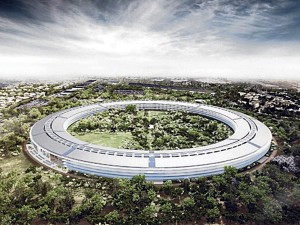The Apple of my eye

IN YEAR or two, Apple starts building its new “Campus 2” in Cupertino. True to their design philosophy, its architecture (by Foster Associates, no less) is very simple: a doughnut-shaped building, very space-ship like in its proportions, and looking clean and streamlined.
The past week, the world was shaken by the terrible news that Steve Jobs resigned from the helm of Apple. Sad, not only for the tech world, but for the world of innovation in design as well.
I first saw an Apple computer—then more popularly called a “Mackintosh”—in the early 1990s. At that time, the Mackintosh came in a case that at best, was an esthetically refined version of the typical monitor and CPU, but definitely better looking. I was impressed, but not blown away. But blown away I was when I first saw the turquoise and white, plastic-encased iMac sometime in the late 1990s.
Compared to any desktop, this iMac was a giant leap into the future. In addition to the techie look that the translucent case projected, the fruity hues of the cover—purple, orange and green—made the computers appear less “geeky” and a lot friendlier to the ordinary consumer. The release of this model was quickly followed by that of its laptop version, the iBook.
I’m not going further into the details of the tech side of which I don’t understand much of anyway, but what I do understand is that the translucent plastic enclosure established Apple as the benchmark for design in the personal computer industry. This was the start of everything beautiful from Apple.
What’s fascinating about the products that Steve Jobs and his team at Apple churn out is that they are near-perfect examples of successful industrial design. Let me draw some comparison. Architecture combines art and science into a creation that performs a function and is built with a time-locked budget. It has the advantage of not being mass-produced into a consumer product.
Architecture may sometimes even be executed at an unreasonable cost. Such is the case with some monuments, museums, institutional buildings or even homes for the rich and superfluous. Industrial design however, has to deal with the challenge of production and salability, as even very high-end products need to have some minimum volume to justify production.

THE NEW Apple “campus” will house 28,000 square meters of offices for 12,000 employees, an auditorium, research labs, a fitness center, carpark, and their own little powerplant. It will again probably be a seamless integration of form and function.
Mind-boggling mix
The iPod, released nearly 10 years ago in November 2001, changed not only the way we listen to music but also the way we relate—in visual and tactile terms—to our handheld gadgets.
At the time of its release, no other device had even come close to the mind-boggling combination of a grasp-friendly size, a wheel-type, thumb-driven, navigation control, a slim and sleek body with well-thought-out proportions, functional details like discreet lock buttons and a finishing material that was so basic yet constructed to look so elegant in its simplicity. The end-product undoubtedly delivers a dazzling and delightful user-experience. It is usually the same with any Apple device.
The key to Apple’s design approach is the simplification of the functions of its various gadgets. Jonathan Ive, its chief designer, lamented that the task of the Apple design team is to “solve incredibly complex problems and make their resolution appear inevitable and incredibly simple, so you have no sense of how difficult it was.”
In the world of design, a minimal approach is possibly the most challenging to execute as the sheer purity of things makes any error more obvious. The other challenge is working in partnership with the operational needs of the equipment, ensuring that all the necessary functions are met despite the pared-down esthetics.
I bought my first iMac on the merit of what it looked like, and I happily immersed myself into its user experience. But there are moments every so often, that I just stare at the aluminum body of my now MacBook Pro, observing the small features like the radius of the curved corners, the heights of each key, the perforation for the speakers, the discreet power button and all the other seeming minute details that have come together into such an elegant piece of equipment. I still look at every Apple product with some sense of awe and wonder.
In a year or two, Apple starts building its new “Campus 2” in Cupertino. True to Apple’s design philosophy, its architecture (by Foster Associates, no less) is very simple: a doughnut-shaped building, very space-ship-like in its proportions and looking clean and streamlined. Its new “campus” will house 28,000 square meters of offices for 12,000 employees, an auditorium, research labs, a fitness center, carpark, and their own little powerplant. It will again probably be a seamless integration of form and function.
Apple’s products are esthetically superior, functionally efficient and extremely user friendly. Apple has shown the world that innovation can be a viable and profitable business model. It has proven that design can be the driving force behind the success of a product. Thank you Apple, for giving design its much-deserved foothold on the world of technology.
Contact the author through designdimensions@abi.ph or through our Asuncion Berenguer Facebook account.
